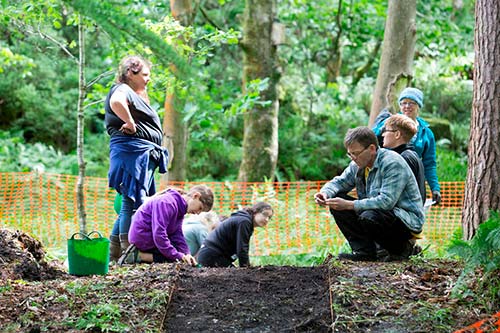Local History Society Report
Celebrating our woodland heritage
Report of talk by Chris Atkinson
Friday, 20 March 2020
At the end of a successful Pennine Prospects Project to explore the history of the woodlands of the South Pennines (jointly funded by the Heritage Lottery Fund, Yorkshire Water, Newground Together and the Green Bank Trust) Chris Atkinson, who led the project, spoke with enthusiasm to Hebden Bridge Local History Society about some of the highlights of the last three years.

Back in 2017, very little was known about how our woodlands were used over the centuries, with only 82 sites of archaeological interest being recorded for the entire woodlands of the South Pennines. At the end of the project 38 woods had been surveyed and a thousand sites of interest recorded. Local community groups were actively involved in the surveys and the excavations, and Bradford University’s department of Archaeology provided support and expertise.
Local woodlands at Hardcastle Crags and Knotts Wood in Todmorden gave up many of their secrets to the volunteers, who identified features such as old route-ways, ruined cottages, wells and quarries as well as veteran trees and evidence of industry such as old mill sites and round platforms used for charcoal burning. These were recorded and reported to the landowners who could then protect them.
The techniques of surveying were largely based on groundwork, but also drew on advanced technology such as LiDAR, which involves lasers and digital 3d models. Old documents such as Manor Court rolls and notices in old newspapers added to the evidence of the importance of our woodlands, with wood being used in local industries as pit-props, bobbins and as charcoal for iron smelting and wool combing. Oak bark was used in tanneries, and bark was also used in the weaving of baskets.
An exciting part of the project were the five community excavations, and it was fascinating to see how the digs added to our knowledge of the woodlands. In Hardcastle Crags, Hirst Wood near Shipley and North Dean woods the excavated sites showed clearly that there was a thick layer of charcoal rich soil, including complete pieces of round wood, below that was a baked surface, on top of the yellow clay that had been levelled for the purpose. Samples of charcoal at Hardcastle Crags were dated from 1386 until 1891 and in Hirst Wood from 1324 till 1736 – a very long tradition of charcoal burning on these sites.
At woods near Ogden reservoir it was decided to cut a trench to re-discover and further investigate part of the Roman road between Manchester and Ilkley which had been photographed in the 1960s. Excavations revealed that the paved surface was not sitting on the usual gravel drainage material, but on sands that over the years had been washed from the hillside. It was disappointing not to be able to examine the construction techniques, however charcoal that was found on this site was dated to 682 and 409 BC.
A very different excavation took place at Long Wood in Copley, where the survey had revealed some World War One practice trenches. Aerial photographs confirmed the finding, and excavations uncovered the parapet and firing step. It seems it was not used for long, probably by recruits who had to be quickly trained in the basics of digging trenches and operating as a team. Metal detectorists hoped to find personal items, but the remains of barbed wire that they did uncover were a sombre reminder of what these young soldiers would face when shipped out from Halifax to France.
Details of the talks programme, publications and of archive opening times are available on the Local History Society website and you can also follow the Facebook page.
With thanks to Sheila Graham for this report
See also

